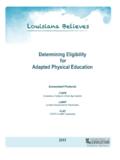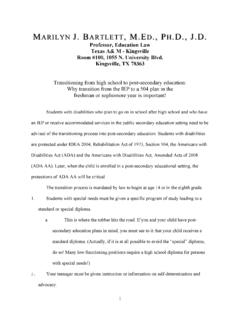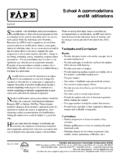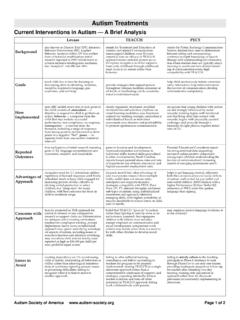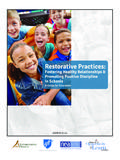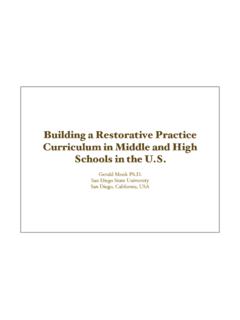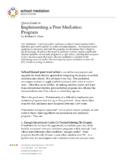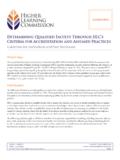Transcription of 20 U.S.C. § 1415 PROCEDURAL SAFEGUARDS
1 Copyright 2004 by Peter W. D. Wright, Esq. wrightslaw : Special Education Law 120 1415 PROCEDURAL SAFEGUARDS Introduction On November 17, 2004, a House-Senate Conference Committee agreed on changes to reauthorize the Individuals with Disabilities Education Act (IDEA). On Friday, November 19, 2004, the full House and Senate voted to reauthorize the Individuals with Disabilities Education Act of 2004. The bill will be submitted to the President who is expected to sign it. Once signed, it becomes law. In our books and training programs, we focus on five key statutes that you should know and understand: Section 1400 - Finding and Purposes Section 1401 - Definitions Section 1412 - State Responsibilities (the Catch All statute) Section 1414 - Evaluations and IEPs Section 1415 - PROCEDURAL SAFEGUARDS (Rules of Procedure) Each of these statutes has some important subsections ( , subsection (a), (b), (c)) and other subsections that have little significance.
2 In this series of five articles, we discuss substantive changes to these five statutes by section and subsection. Text deleted from the IDEA has been struck through. Text that was added to the IDEA is in italics. In some cases, we describe or summarize changes to the law. Comment: Summaries are in a different font. wrightslaw : Special Education Law includes the full text of the Individuals with Disabilities Education Act of 1997. wrightslaw : From Emotions to Advocacy (FETA) includes the five key statutes. These articles include cross-references to wrightslaw : Special Education Law and wrightslaw : From Emotions to Advocacy (FETA) in a different font: Cross-Reference: The PROCEDURAL SAFEGUARDS / Rules of Procedure statute is in pages 67-80 in wrightslaw : Special Education Law and in pages 154-173 in wrightslaw : From Emotions to Advocacy (FETA).
3 20 1415 PROCEDURAL SAFEGUARDS Comment: Section 1415 includes contains subparts (a) through (o). The language of some subsections remained the same while there have been sweeping changes in other provisions. Subsections (n) and (o) were added at the end of Section 1415 . Because PROCEDURAL SAFEGUARDS , , Rules of Procedure are so important, the full text of Section 1415 is included in this article. (a) ESTABLISHMENT OF PROCEDURES - Any State educational agency, State agency, or local educational agency that receives assistance under this part shall establish and maintain procedures in accordance with this section to ensure that children with disabilities and their parents are guaranteed PROCEDURAL SAFEGUARDS with respect to the provision of a free appropriate public education by such agencies. (b) TYPES OF PROCEDURES - The procedures required by this section shall include the following: Copyright 2004 by Peter W.
4 D. Wright, Esq. wrightslaw : Special Education Law 2 (1) An opportunity for the parents of a child with a disability to examine all records relating to such child and to participate in meetings with respect to the identification, evaluation, and educational placement of the child, and the provision of a free appropriate public education to such child, and to obtain an independent educational evaluation of the child. (2) (A) Procedures to protect the rights of the child whenever the parents of the child are not known, the agency cannot, after reasonable efforts, locate the parents, or the child is a ward of the State, including the assignment of an individual (who shall not be an employee of the State educational agency, the local educational agency, or any other agency that is involved in the education or care of the child) to act as a surrogate for the parents; including the assignment of an individual to act as a surrogate for the parents, which surrogate shall not be an employee of the State educational agency, the local educational agency, or any other agency that is involved in the education or care of the child.
5 In the case of-- (i) a child who is a ward of the State, such surrogate may alternatively be appointed by the judge overseeing the child's care provided that the surrogate meets the requirements of this paragraph; and (ii) an unaccompanied homeless youth as defined in section 725(6) of the McKinney-Vento Homeless Assistance Act (42 11434a(6)), the local educational agency shall appoint a surrogate in accordance with this paragraph. (B) The State shall make reasonable efforts to ensure the assignment of a surrogate not more than 30 days after there is a determination by the agency that the child needs a surrogate. (3) Written prior notice to the parents of the child, in accordance with subsection (c)(1), whenever the local educational agency-- (A) proposes to initiate or change; or (B) refuses to initiate or change, the identification, evaluation, or educational placement of the child, or the provision of a free appropriate public education to the child.
6 (4) Procedures designed to ensure that the notice required by paragraph (3) is in the native language of the parents, unless it clearly is not feasible to do so. (5) An opportunity for mediation, in accordance with subsection (e). Comment: Subsection (6) (below) was split into two subsections, (A) and (B). IDEA 2004 includes a new two-year statute of limitations. IDEA did not contain a statute of limitations until now. (6) An opportunity for any party to present a complaint-- (A) with respect to any matter relating to the identification, evaluation, or educational placement of the child, or the provision of a free appropriate public education to such child; and (B) which sets forth an alleged violation that occurred not more than 2 years before the date the parent or public agency knew or should have known about the alleged action that forms the basis Copyright 2004 by Peter W.
7 D. Wright, Esq. wrightslaw : Special Education Law 3of the complaint, or, if the State has an explicit time limitation for presenting such a complaint under this part, in such time as the State law allows, except that the exceptions to the timeline described in subsection (f)(3)(D) shall apply to the timeline described in this subparagraph. (7) procedures that require the parent of a child with a disability, or the attorney representing the child, to provide notice (which shall remain confidential) (7) (A) Procedures that require either party, or the attorney representing a party, to provide due process complaint notice in accordance with subsection (c)(2) (which shall remain confidential)-- (i) to the other party, in the complaint filed under paragraph (6), and forward a copy of such notice to the State educational agency; and (ii) that shall include-- (I) the name of the child, the address of the residence of the child (or available contact information in the case of a homeless child), and the name of the school the child is attending.
8 (II) in the case of a homeless child or youth (within the meaning of section 725(2) of the McKinney-Vento Homeless Assistance Act (42 11434a(2)), available contact information for the child and the name of the school the child is attending; (III) a description of the nature of the problem of the child relating to such proposed initiation or change, including facts relating to such problem; and (IV) a proposed resolution of the problem to the extent known and available to the party at the time. (B) A requirement that a party may not have a due process hearing until the party, or the attorney representing the party, files a notice that meets the requirements of subparagraph (A)(ii). (8) Procedures that require the State educational agency to develop a model form to assist parents in filing a complaint and due process complaint notice in accordance with paragraphs (6) and (7), respectively.)
9 (c) NOTIFICATION REQUIREMENTS - (1) CONTENT OF PRIOR WRITTEN NOTICE - The notice required by subsection (b)(3) shall include-- (A) a description of the action proposed or refused by the agency; (B) an explanation of why the agency proposes or refuses to take the action and a description of each evaluation procedure, assessment, record, or report the agency used as a basis for the proposed or refused action; (C) a statement that the parents of a child with a disability have protection under the PROCEDURAL SAFEGUARDS of this part and, if this notice is not an initial referral for evaluation, the means by which a copy of a description of the PROCEDURAL SAFEGUARDS can be obtained; Copyright 2004 by Peter W. D. Wright, Esq. wrightslaw : Special Education Law 4 (D) sources for parents to contact to obtain assistance in understanding the provisions of this part; (E) a description of other options considered by the IEP Team and the reason why those options were rejected; and (F) a description of the factors that are relevant to the agency's proposal or refusal.
10 Comment: The preceding section (1) about Prior Written Notice includes the original elements in IDEA 97, but in a different sequence and structure. Section (2) about Due Process Complaint Notice (below) creates a new PROCEDURAL requirement that may narrow down issues or may lead to more settlements, after the issue and facts leading to the complaint are clarified. (2) DUE PROCESS COMPLAINT NOTICE - (A) COMPLAINT - The due process complaint notice required under subsection (b)(7)(A) shall be deemed to be sufficient unless the party receiving the notice notifies the hearing officer and the other party in writing that the receiving party believes the notice has not met the requirements of subsection (b)(7)(A). (B) RESPONSE TO COMPLAINT - (i) LOCAL EDUCATIONAL AGENCY RESPONSE - (I) IN GENERAL - If the local educational agency has not sent a prior written notice to the parent regarding the subject matter contained in the parent's due process complaint notice, such local educational agency shall, within 10 days of receiving the complaint, send to the parent a response that shall include-- (aa) an explanation of why the agency proposed or refused to take the action raised in the complaint; (bb) a description of other options that the IEP Team considered and the reasons why those options were rejected; (cc) a description of each evaluation procedure, assessment, record, or report the agency used as the basis for the proposed or refused action.

